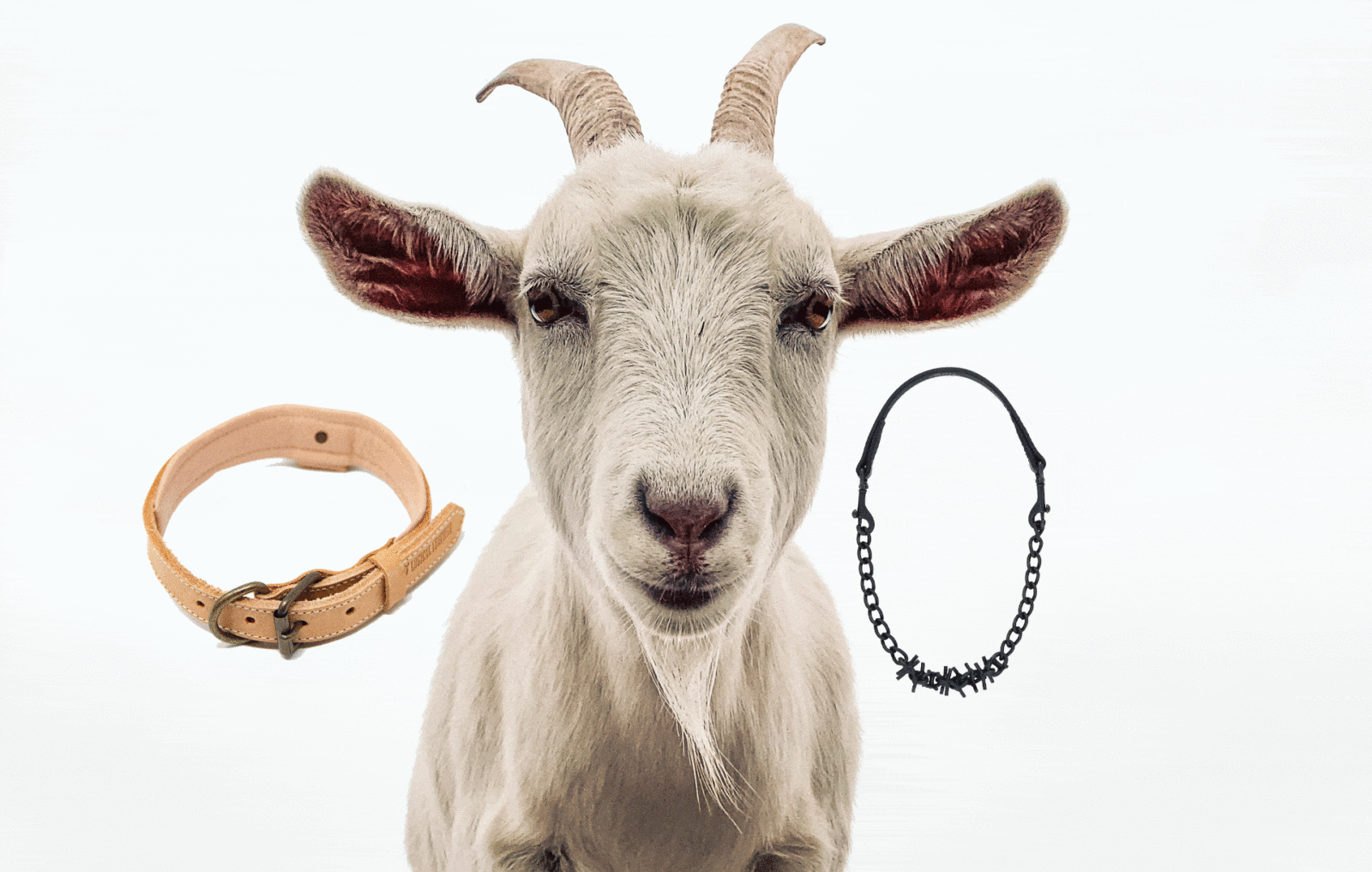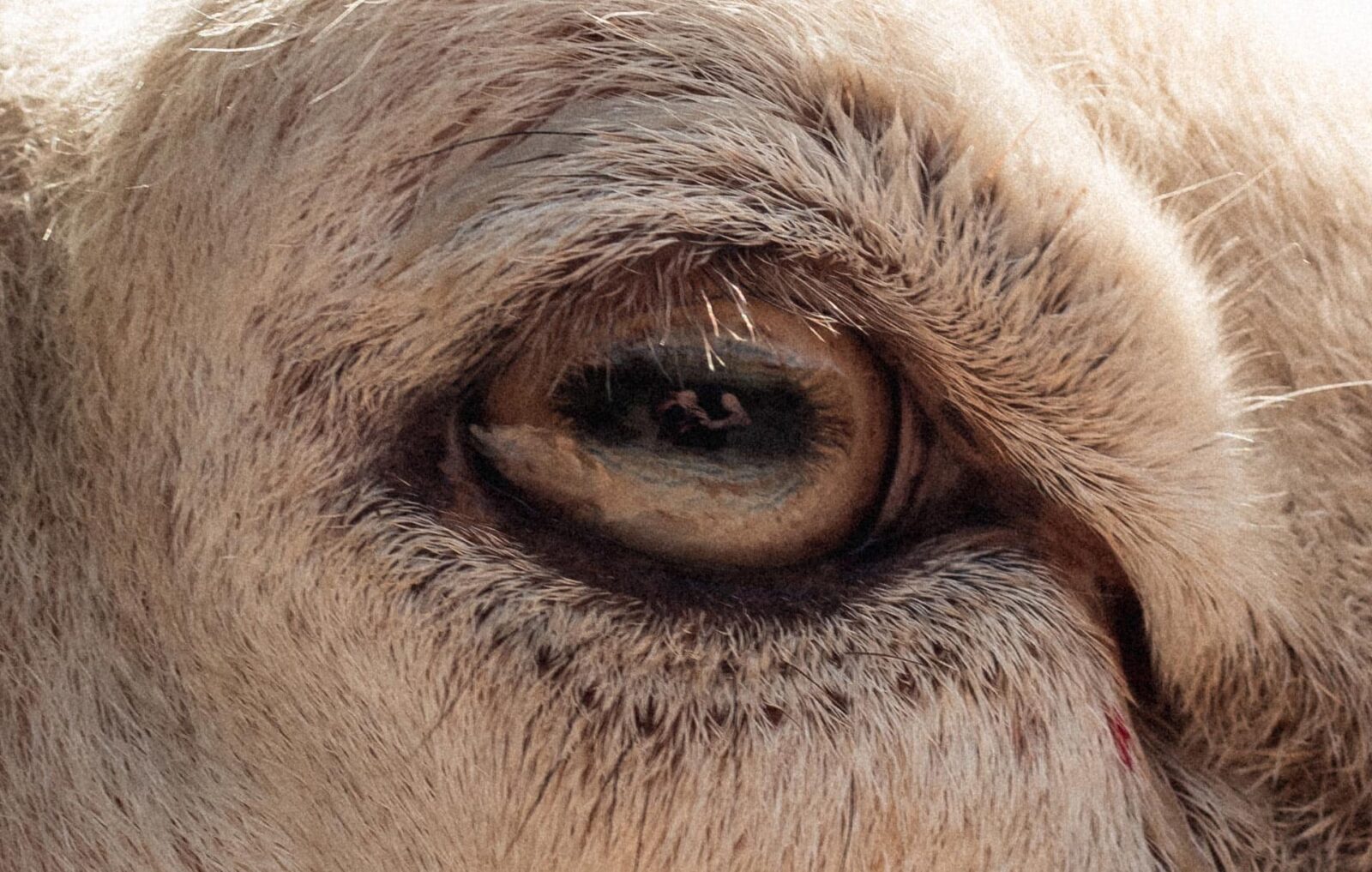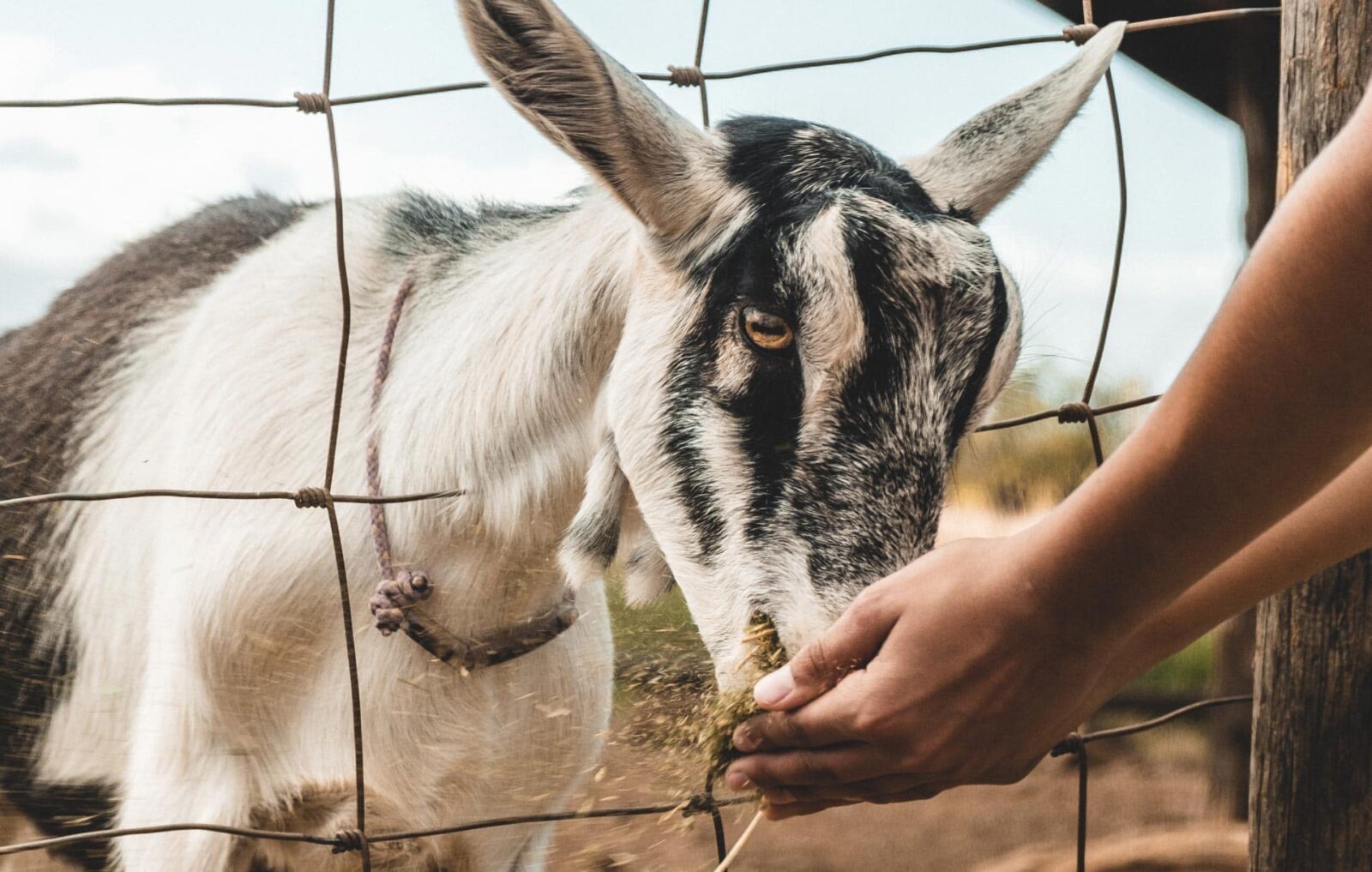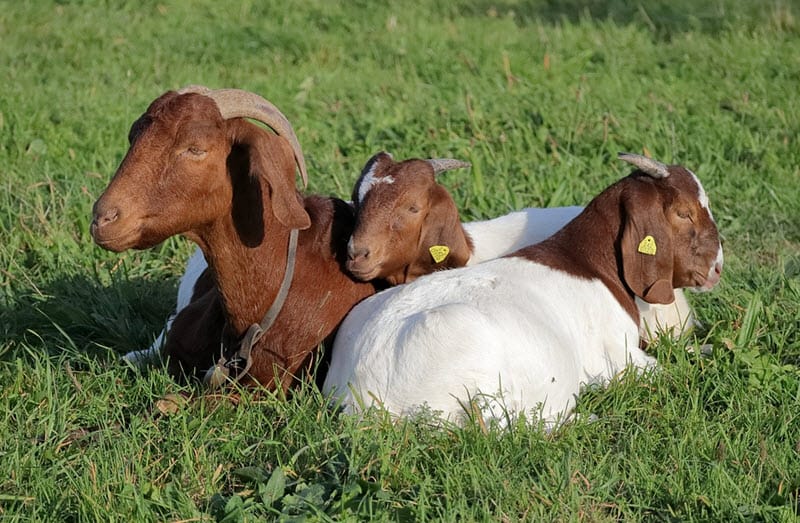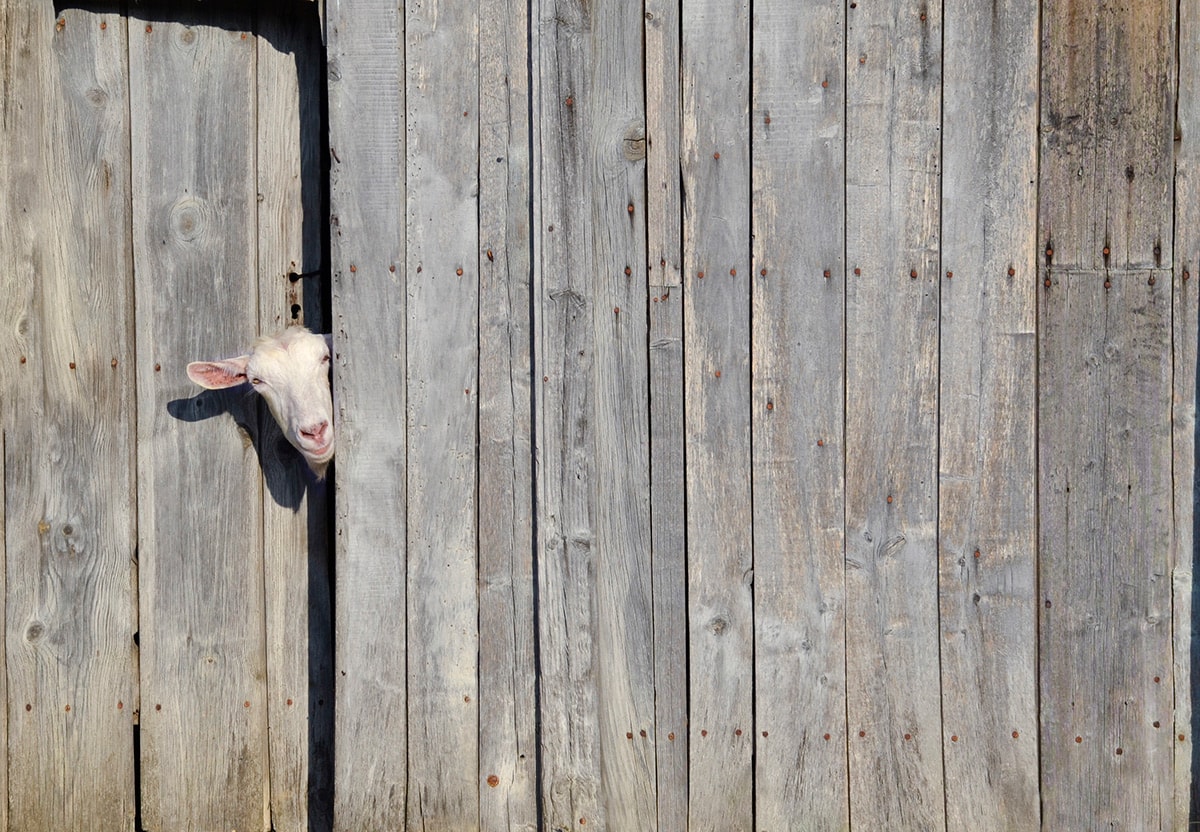Goats’ Grazing Habits: Can They Thrive on Grass? As a seasoned gardener, homesteader, and DIYer, there’s nothing quite as rewarding as observing the intricate dance between animals and the land they call home. Over the years, my farm and homestead have taught me that nature holds its secrets close, offering us subtle clues if we’re willing to listen. Among the various creatures that have graced my humble abode, goats have become an indispensable part of my sustainable ecosystem. These curious and nimble animals have a reputation for being voracious eaters, but like any good gardener, I often find myself pondering their grazing habits and whether they can truly thrive on grass alone. Join me on this exploration of our caprine companions’ eating preferences and let’s delve into the age-old question: Can goats truly thrive on grass?
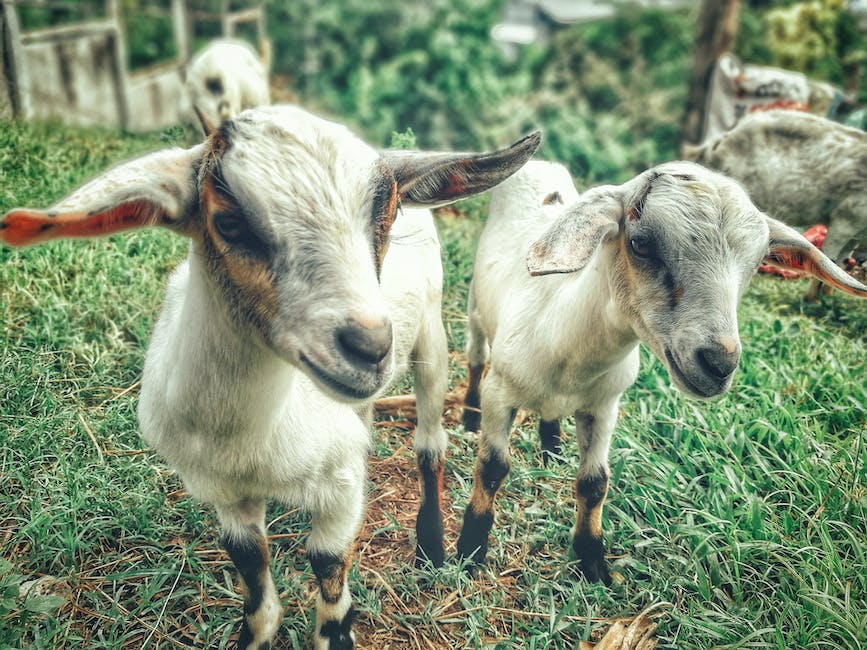
Introduction: Goats’ Grazing Habits: Can They Thrive on Grass?
Now, let’s dispel any doubts and myths right from the get-go. Goats, those nimble-footed marvels of nature, are known for their voracious appetite and their uncanny ability to devour just about anything in sight. But let’s remember, goats have been our companions since time immemorial, and oh, the things we’ve learned from them! You see, despite their well-deserved reputation, goats are not just indiscriminate munchers; they have discerning palates and can be quite particular about their food choices.
It is true, my dear homesteaders, that grass is a staple for goats, their bread and butter if you will. But the secret lies in the diversity of their grazing options. These intelligent creatures understand that variety truly is the spice of life. They are hard-wired to explore the natural wonders that dew-kissed meadows and verdant pastures offer, seeking out nourishing weeds, herbs, and shrubs along the way.
So, to answer the age-old question, yes, dear friends, goats can indeed thrive on grass! But let’s not forget to honor their inner culinary adventurers. By embracing rotational grazing methods, we can ensure our goats’ diets are enriched with a medley of delectable delights that will contribute to their overall health and well-being. Mixing in forage crops like clover or alfalfa, as well as allowing access to browse areas with woody shrubs, can provide our goats with a buffet fit for royalty. Remember, balance is key in the goat kingdom!
Join me as we unravel the mysteries of the goat’s grazing habits, delving into their repertoire of forage options and exploring the symbiotic relationship between these marvelous creatures and the very essence of life itself: the earth beneath our feet. It’s time to revel in the wisdom of nature and unlock the secrets of goat husbandry. Get ready to witness the grace and contentment that emerges from a well-fed goat, and let us together embark on this unforgettable journey!

1. Understanding the Natural Diet of Goats: Grass as a Staple
When it comes to raising goats, there’s one thing that has stood the test of time: they are natural grazers. These gentle creatures have a deep-rooted connection to the land, and their natural diet reflects that. As a seasoned gardener and homesteader, I have come to realize the importance of grass as a staple in their diet.
Goats have been happily munching on grass since ancient times, and their digestive system is well-suited for it. Grass provides them with the essential nutrients and fibers they need to thrive. But it’s not just any grass; goats have a discerning taste for a variety of grasses and forages, each offering its unique blend of flavors and nutrients.
One of the reasons why grass is such an essential part of a goat’s diet is because it acts as a natural buffer against parasites. Certain grasses, such as orchard grass and fescue, contain compounds that help control internal parasites in goats. This natural defense mechanism, combined with proper rotation of pastures, can significantly reduce the need for chemical dewormers, promoting a more holistic approach to goat care.
Goats are selective grazers and tend to favor young, tender shoots. They have a knack for seeking out the most nutritious parts of the grass, and this can be incredibly beneficial for maintaining their overall health. By allowing goats access to pasture, you are giving them the opportunity to engage in their natural browsing behavior, promoting physical and mental well-being.
- Grass provides a rich source of vitamins and minerals, including Vitamin A, B, and E.
- The high-fiber content in grass aids in proper digestion and prevents gastrointestinal issues.
- Goats love the challenge of browsing and enjoy the mental stimulation it provides.
- Access to fresh grass and forage can improve milk production in lactating does.
Remember, providing a natural diet for your goats is crucial for their overall health and happiness. While supplements and grains can have their place, nothing can truly replace the wonders of fresh, nourishing grass. So, let your goats roam, explore, and savor the earth’s bounty. After all, there’s nothing quite like the taste of grass under the warm sun, reminding us of the beauty and simplicity of nature’s wisdom.
2. The Nutritional Benefits of Grass for Goats: A Comprehensive Analysis
When it comes to nourishing our beloved goats, few things compare to the incredible benefits of grass. As a seasoned gardener and homesteader, I have witnessed firsthand the transformative power of a well-balanced diet for our furry friends. Today, I want to delve deeper into the nutritional advantages that grass provides, allowing you to better understand how to keep your goats healthy and thriving.
1. Rich in essential vitamins and minerals: Grass is a veritable treasure trove of vital nutrients for goats. It contains a plethora of vitamins, including A, D, E, and K, which are crucial for their overall well-being. Additionally, it boasts an array of minerals like calcium, magnesium, and phosphorus, necessary for bone development and strong immune systems.
2. Excellent source of digestive fiber: Goats have complex digestive systems, and a diet high in fiber is essential to maintain their optimal health. Grass, with its abundant cellulose content, offers a natural source of dietary fiber that aids digestion and ensures proper bowel movements for these magnificent creatures.
3. Promotes healthy weight management: Just as we humans strive for a well-balanced diet, so do our goats. Grass provides a wholesome option for weight management, as the fiber content helps to regulate their appetite and keep them feeling satiated. It’s nature’s way of giving them the sustenance they need without overeating.
4. Supports optimal milk production: For those fortunate enough to have dairy goats, grass becomes even more critical. High-quality grass offers the necessary energy and nutrients for milk production, leading to rich, creamy goodness that both you and your family can enjoy. The saying “you are what you eat” applies to goats too!
In conclusion, the nutritional benefits of grass for goats are undeniable. From essential vitamins and minerals to digestive fiber and weight management, it plays a crucial role in keeping our goats healthy and strong. So, take joy in watching your goats graze on the lush pastures, knowing that they are nourishing themselves in the most natural way possible. After all, Mother Nature truly knows best!
3. Grazing Patterns of Goats: How Grass Consumption Impacts Their Health
When it comes to keeping goats happy and healthy, understanding their grazing patterns is essential. As a seasoned gardener and homesteader, I’ve spent countless hours observing these fascinating creatures as they roam the land, nibbling on nature’s bounty. Let me share with you some of the valuable insights I’ve gained over the years.
1. Browse vs. Grazing: Goats have a unique way of foraging, often referred to as “browse” rather than simple grazing. Unlike other livestock, goats have a preference for browsing on shrubs, leaves, and woody plants. They love to explore their surroundings, indulging in a diverse range of plant species. This diverse diet not only keeps them content but also boosts their overall health.
2. Impact on Soil Health: Goats are nature’s own eco-friendly tillers. As they munch on grass and brush, their hooves aerate the soil, leading to enhanced water absorption and increased microorganism activity. This natural tilling helps promote a healthy soil structure and prevents the formation of compacted areas that restrict plant growth. It’s like having a team of farmhands and garden helpers all rolled into one furry package!
3. Managing Overgrazing: While goats are fantastic at clearing areas of excess vegetation, overgrazing can be a concern if not managed properly. Their voracious appetites can lead to bare patches and soil erosion. To prevent this, rotational grazing is key. Create designated grazing areas and rotate your goats between them, allowing for proper regrowth and preventing the depletion of specific plant species. It’s a win-win situation for both goats and the environment!
4. Nutritional Balance: Monitoring your goats’ grazing patterns also gives you important insights into their nutritional needs. By observing the plants they gravitate towards, you can identify any deficiencies or imbalances in their diet. Supplementing their grazing with appropriate feed, minerals, or even herbal remedies can help maintain their optimal health and well-being.
So, the next time you see your goats contentedly munching away in the pasture, take a moment to appreciate the intricate dance between these curious creatures and the land. By understanding their grazing patterns and adapting our management practices, we can ensure their health and happiness while fostering a sustainable relationship with nature. Remember, my fellow gardeners and homesteaders, the earth provides, and we must nurture.
4. Examining the Challenges: Potential Issues with Grass-Based Diet for Goats
As an advocate for sustainable and natural practices, I firmly believe that a grass-based diet is the way to go for most goats. However, it’s important to acknowledge that every approach has its challenges. When it comes to feeding your goats primarily on grass, here are a few key potential issues to consider:
Grazing limitations: While goats are known for their ability to forage on a variety of plants, it’s crucial to ensure they have access to a diverse range of grasses and other forages. Overgrazing can occur if the land is not properly managed or if the goat population exceeds the carrying capacity. Maintaining a rotational grazing system and regularly monitoring the pasture’s health will help prevent this issue.
Nutritional deficiencies: Depending solely on grass may lead to certain nutritional deficiencies in your goats. While high-quality pasture can provide a significant amount of nutrients, it’s important to supplement their diet with minerals such as copper, selenium, and zinc. Providing access to a mineral lick or incorporating mineral-rich plants like comfrey into the pasture can help address this issue.
Seasonal fluctuations: Grass availability and quality can fluctuate throughout the year, especially during droughts or extreme weather conditions. It’s crucial to have a backup plan in place to ensure your goats have access to adequate forage and nutrition during times when the grass is scarce. This could involve stockpiling hay or growing alternative forages such as legumes or brassicas to supplement their diet during challenging seasons.
Bloating: While a grass-based diet is generally healthy for goats, certain types of grasses, particularly those high in soluble carbohydrates like clover, alfalfa, or cereal grains, can lead to bloating. It’s important to monitor the types and amounts of grasses your goats consume to prevent this issue. Incorporating diversity in their forage options and introducing new plants gradually can help mitigate the risk of bloating.
By understanding these potential challenges and implementing appropriate strategies, a grass-based diet can still be an excellent choice for your goats. Remember, observing and adapting to the unique needs of your goats and the land they graze on will help you create a harmonious and sustainable system that benefits both the animals and the environment.
5. Building a Balanced Grazing Regimen: Incorporating a Diverse Forage Mix
Ah, my fellow land stewards! Today, let’s dive into the art of building a balanced grazing regimen that will nourish our beloved livestock and promote a healthy ecosystem. As seasoned farmers and homesteaders, we know that the key to sustainable grazing lies in incorporating a diverse forage mix. So, grab your hat and let’s explore this vital aspect together!
1. **The Magic of Mixing:** Just like a symphony, a diverse forage mix creates harmony in your pasture. By blending different grasses, legumes, and forbs, you’re not only providing a varied diet for your animals but also fostering soil health. Each plant brings its unique set of nutrients and benefits to the table, enhancing the overall resilience of your pasture.
2. **Tapping into Nature’s Wisdom:** Look to your local native plants as a cornerstone of your forage mix. These plants have evolved over countless generations and offer unparalleled resilience and resourcefulness. When incorporated in moderation, they can enrich your pasture’s biodiversity and provide natural remedies for common livestock ailments.
3. **Timing is Everything:** Seasonal grazing is the secret sauce to maintaining a well-balanced pasture. Rotate your animals through different sections, allowing ample time for the plants to recover and regenerate. This rest-period not only ensures a continuous food supply but also promotes deep root growth and prevents soil compaction.
4. **Monitoring and Adjusting:** Keep a keen eye on your pasture’s health. Observe how your animals interact with different forages and adjust accordingly. Some plants may be devoured enthusiastically, while others are left untouched. Utilize this knowledge to tweak your forage mix, catering to both palatability and nutritional requirements.
Remember, crafting a balanced grazing regimen is an ongoing process that requires careful observation and thoughtful adjustment. Be patient, my friends, for nature is our greatest teacher. By incorporating a diverse forage mix, we pave the way for thriving livestock, resilient pastures, and a deeper connection with the beautiful tapestry of life that surrounds us.
Nature has bestowed upon us the bountiful gifts of the land; let us nurture it in return.
6. Maximizing Nutrient Intake: Strategies to Enhance Goats’ Digestion of Grass
When it comes to raising goats, ensuring they receive adequate nutrition is crucial for their overall health and productivity. While grazing on grass is a natural instinct for these magnificent creatures, there are ways we can optimize their digestion to maximize nutrient intake. Drawing from my years of experience working with goats on the farm, I’ve discovered a few strategies that can make a world of difference in their diet.
1. Rotational Grazing: Implementing a rotational grazing system allows goats to have access to fresh, nutrient-rich forage. By dividing the pasture into smaller sections and rotating the goats to a new patch every few days, the grass has a chance to regrow, ensuring a constant supply of high-quality feed. This practice not only increases nutrient intake but also helps prevent overgrazing and improves soil fertility.
2. Supplement with Legumes: Introducing legumes into the goats’ diet can greatly enhance their digestion of grass. The legumes, such as clover or alfalfa, have higher protein content and can act as a natural source of digestive enzymes. Consider planting legumes in areas of the pasture or offering them as a supplement, allowing goats to gain additional nutrients while also enhancing their ability to break down grasses effectively.
3. Incorporate Herbal Supplements: The power of herbs should never be underestimated when it comes to improving digestion in goats. Some herbs, such as thyme, mint, or chamomile, have been known to stimulate appetite, aid in digestion, and support overall gut health. You can experiment with incorporating these herbs into their diet through fresh sprigs, dried leaves, or even as a tea mixed with their water.
4. Provide Access to Mineral-rich Soil: Goats have a natural inclination to seek out certain minerals when their bodies are deficient. By offering them access to a designated area where they can freely roam and nibble on mineral-rich soil or mineral blocks, you are providing them with the opportunity to self-regulate their intake of necessary minerals like calcium, phosphorus, and magnesium.
Remember, every goat is unique, and it may take some trial and error to find the perfect combination of strategies that work best for the specific needs of your herd. But with patience, observation, and a deep connection to the natural world, you’ll discover the keys to enhancing your goats’ digestion of grass and nurturing their overall well-being.
7. Preventing Overgrazing: Effective Management Techniques for Sustained Grazing
As a seasoned gardener and homesteader, I have seen the impact that overgrazing can have on our precious land. It is our responsibility to ensure that our grazing practices are sustainable and do not harm the ecosystem. Overgrazing occurs when livestock continuously graze on a limited area, leading to the depletion of resources and degradation of the land. But fear not, for there are effective management techniques that can help us prevent overgrazing and promote sustained grazing.
1. Rotational Grazing: One of the most effective techniques for preventing overgrazing is rotational grazing. This method involves dividing your pasture into smaller paddocks and rotating the livestock between them. By giving each paddock enough time to recover and regrow, you allow the land to replenish itself and ensure that the animals have access to fresh and nutritious forage. Rotational grazing also helps distribute manure evenly, promoting natural fertilization and soil health.
2. Resting Periods: Just like us, the land needs time to rest and recover. Designating resting periods for your pastures can have a tremendous impact on preventing overgrazing. During these periods, you can either keep your livestock in a different pasture or provide them with supplementary feed. Resting periods allow the grass and other vegetation to rejuvenate, strengthening their root systems and ensuring their long-term survival.
3. Monitoring Forage Growth: Regularly monitoring the growth of your forage can provide valuable insights into the condition of your pasture and help you prevent overgrazing. Keep an eye on the height of the grass and its overall health. If the grass is consistently grazed down to the ground, it’s a clear sign that you may need to adjust your grazing management. By closely monitoring forage growth, you can make informed decisions about when and where to move your livestock, ensuring a sustainable and productive grazing system.
Remember, preventing overgrazing is not just about protecting your land. It’s about preserving the delicate balance of nature and leaving a legacy for future generations. By implementing these effective management techniques, we can create a harmonious relationship between our livestock and the land, ensuring its bountiful abundance for years to come.
8. Ensuring Adequate Protein Intake: Supplementing Grass Grazing with Legumes
When it comes to sustainably raising livestock or nourishing our own bodies, protein is one of the key building blocks we can’t compromise on. As a seasoned gardener and homesteader, I’ve long believed in the power of diversity in our agricultural practices. That’s why I’ve turned to a time-honored solution: supplementing grass grazing with legumes.
Legumes, such as clovers, vetch, or alfalfa, are much more than just vibrant splashes of green in your fields. They are nature’s gift, enriching the soil with nitrogen and providing a valuable protein source for our animals. This ancient practice not only ensures a healthier and more balanced diet for our livestock but also helps maintain the fertility of our land, promoting a virtuous cycle of growth.
The beauty of incorporating legumes into your grazing system lies in their nitrogen-fixing abilities. These incredible plants have a symbiotic relationship with beneficial soil bacteria that allows them to convert atmospheric nitrogen into plant-available forms. By planting legumes alongside your grasses, you automatically enhance the nitrogen content of your soil, reducing the need for synthetic fertilizers. This regenerative approach not only saves you money but also lends itself to a more eco-conscious and self-sufficient farming lifestyle.
Another benefit of supplementing grass grazing with legumes is the improved nutritional profile it offers. While grass provides a solid foundation, it often falls short in meeting the protein requirements of our livestock. By introducing legumes into their diet, we can bridge this gap and provide our animals with the essential amino acids they need for healthy growth and development. The added protein not only promotes robust muscle development but also enhances milk production in dairy animals, ensuring healthy offspring and sustainable yields.
So, whether you’re tending to a small homestead or managing a larger farm, consider the ancient wisdom of integrating legumes into your grazing system. Experiment with various legume species that thrive in your climate and soil conditions, and watch as your animals thrive on the benefits of this natural protein supplement. Let us remember that the path to a harmonious coexistence with the earth lies in honoring its traditions while embracing innovation for a brighter future.
9. Transitioning to a Grass-Focused Diet: Recommendations for a Smooth Transition
As we continue our journey towards a more sustainable and self-sufficient lifestyle, one of the most impactful changes we can make is transitioning to a grass-focused diet. Embracing the natural grazing habits of our ancestors, this dietary shift not only nourishes our bodies, but also honors the interconnectedness of all life on our precious planet.
The Benefits of a Grass-Focused Diet
Transitioning to a grass-focused diet holds numerous benefits, both for our health and the environment. Let’s take a closer look at the transformative power of this dietary shift:
- Improved Nutritional Profile: Grass-fed meats and dairy products are rich in omega-3 fatty acids, conjugated linoleic acid (CLA), and antioxidants, providing us with essential nutrients for optimal well-being.
- Sustainable Agriculture: By prioritizing grass as the primary feed for livestock, we support regenerative farming practices, reduce the environmental impact of conventional feed production, and help combat climate change.
- Preservation of Biodiversity: Encouraging the growth of diverse grasses and forage plants contributes to the preservation of habitats for native flora and fauna, fostering a healthy ecosystem.
Tips for a Successful Transition
The shift to a grass-focused diet may seem daunting at first, but with a mindful approach, it can be a seamless and rewarding journey. Here are some practical recommendations to guide you:
- Start Gradually: Introduce grass-fed products slowly into your diet, allowing your taste buds to adapt to the unique flavors and textures. Begin by incorporating one grass-fed meal a week, then gradually increase the frequency.
- Find Trusted Sources: Seek out local farmers, ranchers, and suppliers who prioritize sustainable and ethical practices. Get to know the source of your food, ensuring it comes from animals raised on well-maintained pastures.
- Experiment with Recipes: Explore the vast array of delicious grass-fed recipes to ignite your culinary creativity. From savory grass-fed steak to creamy dairy products, there are numerous mouthwatering dishes waiting to be discovered.
- Connect with Nature: Cultivate a deeper appreciation for the grasses and pastures that nourish us. Spend time observing the beauty of grazing animals roaming freely and appreciate the symbiotic relationship between the land and its inhabitants.
Remember, transitioning to a grass-focused diet is a transformative journey, not a destination. Embrace the process, learn from the land, and savor the bountiful rewards it brings to your health, the environment, and your connection with nature.
10. Assessing the Economic Viability: Cost-effectiveness of Grass Grazing for Goats
As a gardener, I’ve always believed in finding sustainable solutions for all aspects of my homestead. One of the most cost-effective and environmentally friendly ways to feed my goats has been through grass grazing. Not only does it provide a natural and nutritious diet for them, but it also allows me to make the most of the land I have.
When assessing the economic viability of grass grazing for goats, there are a few factors to consider. First and foremost, you need to look at the initial investment. Setting up a well-fenced pasture area will require some upfront cost, but in the long run, it pays off. Take the time to calculate the cost of materials, fencing, and any necessary equipment like water troughs.
Remember, though, that the benefits of grass grazing go beyond just saving money. Grazing reduces the need for purchasing expensive commercial feed, and it also cuts down on labor and time spent preparing feed. Additionally, goats that graze on diverse grasses and plants tend to have better overall health, reducing vet bills and medication costs.
But the cost-effectiveness of grass grazing doesn’t stop there. When goats graze, they naturally fertilize the land, helping to improve soil fertility and reducing the need for synthetic fertilizers. This, in turn, leads to increased yields in your garden and crops, creating a cycle of sustainability that benefits the entire homestead.
So, as you assess the economic viability of grass grazing for your goats, take into account not just the upfront costs, but also the long-term benefits. Consider the savings on feed, labor, and veterinary expenses, as well as the positive impact on soil fertility. Ultimately, grass grazing is a smart investment that not only benefits your goats but also nurtures the health and vitality of your entire homestead.
Insights and Conclusions
In conclusion, goats’ grazing habits reveal their incredible adaptability and resourcefulness in thriving on a predominantly grass-based diet. Despite their reputation as indiscriminate browsers, goats possess the unique ability to selectively consume nutritious grasses while avoiding harmful plants, making them invaluable assets in sustainable land management.
Their well-developed rumen system, efficient digestion, and natural browsing instincts enable them to extract maximum nutrition from grasses, even in challenging environments. This adaptability allows goats to flourish in various habitats and climates, from lush pastures to arid landscapes.
However, it is essential to recognize that while goats can survive on grass, their dietary needs extend beyond just grass intake. Supplementing their diet with mineral-rich forages, such as legumes and shrubs, enhances their overall health and productivity.
In harnessing the power of goats’ grazing habits, we can leverage their innate ability to transform landscapes, rejuvenate soil, and control invasive plant species. Proper management practices, including rotational grazing and effective monitoring, are key to ensuring their welfare and maximizing their positive impact on the ecosystem.
As we continue to seek sustainable solutions for agricultural practices and land management, goats’ ability to thrive on grass exemplifies nature’s intricacy and ingenuity. Their presence in grasslands not only supports biodiversity but also provides opportunities for socio-economic development, particularly in communities where grazing pastures hold significant importance.
Therefore, by understanding and harnessing the unique grazing habits of goats, we can foster a harmonious relationship between these remarkable animals, the environment, and our sustainable future. With mindful stewardship, we can continue to unlock the full potential of goats’ grazing abilities, contributing to a greener and healthier planet for generations to come.



